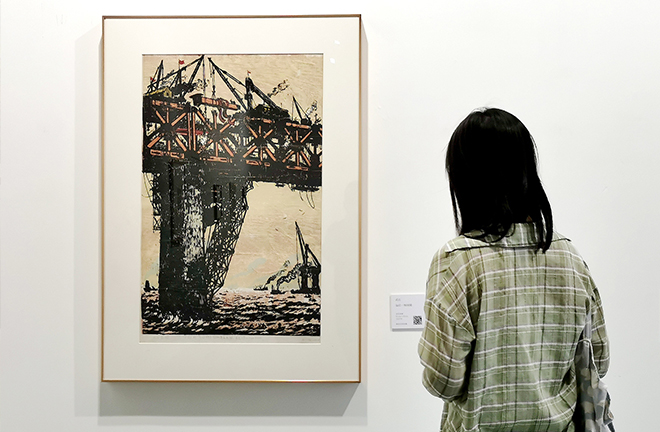Webinar probes pictorial and audio narratives

An exhibition on the theme of “image narratives of industrial memory” in Wuhan, Hubei Province, on May 13, 2022 Photo: CFP
On Dec. 24, 2022, the Institute of Narratology was inaugurated online and the concurrent Webinar on Frontier Issues of Narratology was held by Jiangxi Normal University (JXNU). Participating scholars exchanged views on the future development and transformation of narratology and other frontier topics, with the aim of constructing Chinese discourse and narrative systems and better telling Chinese stories.
Image narratives
In the early days of human history, pictures and texts were virtually interchangeable. The two could not be divorced and both served the purpose of recording. The large number of narrative pictures found on ancient Chinese ceramics makes this material one of the earliest by which Chinese stories were conveyed to the world. Ni Aizhen, a research fellow from the Institute of Literature and Culture at the Jiangxi Academy of Social Sciences, said that numerous narrative pictures on ancient Chinese ceramics, especially on porcelain for civil use and export, are different from that on court paintings, literati paintings, fiction and opera illustrations, due to the particularity of texture, function, production, circulation, and consumption of material carriers. They feature the legan culture [literally happy-sense culture, as opposed to Western guilt culture and Japanese shame culture] and other characteristics of image narratives.
In Ni’s opinion, these images not only make history visible and tangible. They mutually interpret, verify, and complement the written texts and images of other media, contributing a new perspective to explore the spread and acceptance of literary works among the people, as well as differences in Chinese and Western narrative traditions and culture.
Image narration is a kind of “pictorial illustration” in presence. It is an indisputable fact that modern media has been excessively obsessed with “presence” narration. The presence of symbolic imagery has been imitated throughout the contemporary narrative. The “eidetic intuition” of phenomenology and its praise for image cognition are utilized by various types of narrative behaviors. “Words are but winds, but seeing is believing” has become the most important narrative strategy and signification principle. Zhao Xianzhang, a professor from the School of Liberal Arts at Nanjing University, said the strong dissemination power of images entices writers to emulate the presence. As image worship becomes increasingly intense and the relationship between image and linguistic narratives grows increasingly complex, it is necessary to contrive profound theoretical explanations on what image-narrative “presence” means, whether “presence” is unique to image symbols and not shared by linguistic representation, and what intertextual representations exist between “presence” and “absence” when literature and image share the same text.
Long Diyong, dean of the School of Art at Southeast University, noted that the motivation of writers to produce novels varies among authors. Those that aim at breaking with traditional linear narrative to create new narrative modes are often inspired by a certain visual image. The narrative mode is often a cross-media narrative, or an imitation of images via phraseology.
Novelists ought to create narrative works with either features of plastic arts or spatial features, Long continued. Generally, cross-media narrative works constructed on the basis of visual images are mainly manifested in two modes in terms of narrative structures: “comic strip via phrasing” for its narrative mode, “viewpoint-juxtaposition narrative,” in which characters in the same story represent different points of view respectively.
Audio narratives
Previously neglected soundscapes and auditory events are found to produce unexpected effects. Liu Bizhen, deputy dean of the School of Education at JXNU, highlighted the necessity of constructing auditory space, re-understanding the role and value of narrative subjects, dialoguing with the author and the text, and giving new interpretations in light of respective situations. In doing so, reading becomes a two-way interaction between narration and listening, unleashing greater charms inherent in literature.
Liu Yalyu, executive deputy director of the Institute of Narratology at JXNU, said that the study of auditory culture is not meant to subvert or deny visual culture, but to restore the ignored and obscured sensory culture by criticizing the masking effect of prioritizing ocularcentrism, appealing for multiple interactions between visual, auditory, and other sensory channels, so as to restore the “ecological” balance in the sensory field.
Examining auditory narratives helps acquire a deeper understanding of our own narrative traditions. Fu Xiuyan, head of the academic committee of the Institute of Narratology at JXNU, compared Chinese and Western narrative traditions from the perspective of sensory dependence. In contrast with the Western “visual sense first” and “seeing as knowing,” China has maintained many characteristics of an auditory society for centuries. Although ancient Chinese attached importance to “seeing” as well, listening more commonly dominated, and even referred to all types of perception, including the visual sense. The difference between Chinese and Western narratives stems from their respective structural concepts, including the sensory dependence behind them. This perspective enables deeper immersive understanding of cultural phenomena, including literature.
With abundant auditory narrative scenarios and images in narrative works, the auditory turn will open up new resources for narratology. To better serve the goal, scholars are tasked with reversing the imbalance of visual and auditory senses in narratology and systematically researching narratives from the auditory dimension. Zhou Zhigao, a professor from the School of Foreign Language at Jiujiang University, called for the construction of appropriate discourse frameworks and theoretical tools, and establishing discourse systems and motivation for auditory narrative research. In the meantime, it is advisable to illuminate how soundscapes enrich the construction of fictional worlds by listening to the voices in narrative works.
Edited by YANG LANLAN
